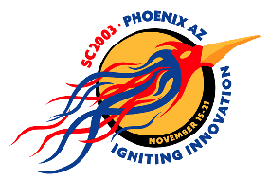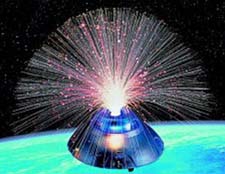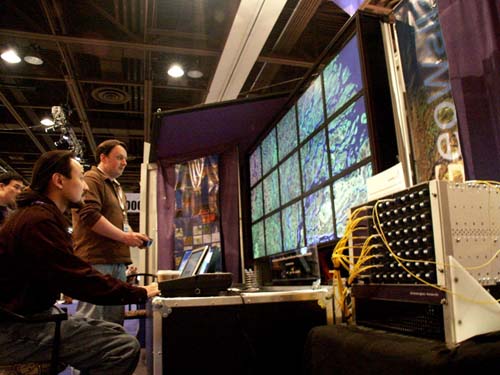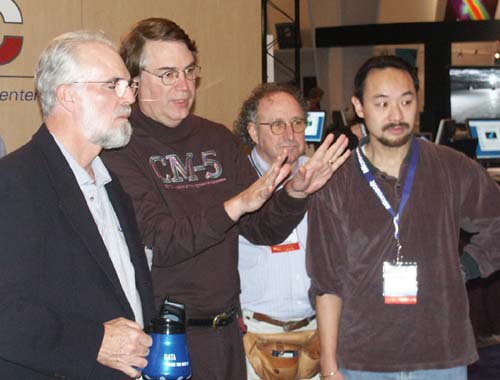| ABOUT |
|
SC 2003 Phoenix, Arizona November 15-21, 2003 |
 |
 SC 2003 Phoenix, Arizona November 15-21, 2003 Panel on “Supernetworking Transforming Supercomputing” November 19, 2003 Moderator: Steven J. Wallach (Chiaro Networks) Panelists: Daniel J. Blumenthal (University of California, Santa Barbara) Andrew A. Chien (University of California, San Diego) Jason Leigh (University of Illinois at Chicago) Larry Smarr (University of California, San Diego) Rick L. Stevens (Argonne National Laboratory / University of Chicago) Description:  For the last decade, Moore’s Law has dominated supercomputing architecture, since it was on a steeper exponential than either bandwidth or storage.
Furthermore, during the 1990s, the commoditization of processors allowed for super-exponential growth in computing power through the parallelization of processors - that is, we were able to multiply Moore’s Law for the growth of individual processor speeds by the 500-fold increase in the number of processors in a single parallel computer (from 4 processors in the early 1990’s to 2000 processors today).
For the last decade, Moore’s Law has dominated supercomputing architecture, since it was on a steeper exponential than either bandwidth or storage.
Furthermore, during the 1990s, the commoditization of processors allowed for super-exponential growth in computing power through the parallelization of processors - that is, we were able to multiply Moore’s Law for the growth of individual processor speeds by the 500-fold increase in the number of processors in a single parallel computer (from 4 processors in the early 1990’s to 2000 processors today).A fundamental architectural shift has occurred in this decade, in that storage and particularly networking bandwidth are growing much faster than Moore’s Law. The super-exponential in bandwidth is caused by parallelization in the number of Lambdas, independent light paths down a single fiber optic, multiplied by the increase of the bandwidth of the individual light paths (DWDM). The TeraGrid was the first example of a national-scale supercomputer with dedicated optical paths - 4x10Gbps. The Panel reviews the basic engineering trends in processors, storage and optics, and then examines a number of federally funded projects which are exploring the vision laid out by Steve Wallach at Supercomputing 2000 in which a petaflop computer by 2010 will be an optical switch with compute and storage peripherals. In addition, the Panel examines how dedicated multi-Lambda optical circuits could radically change the architecture of distributed cyberinfrastructure and the ability for application end-users to use that infrastructure to carry out 21st-century scientific research. Presentations: Super Networking Evolution of the Grid Steven Wallach WALLACH-SC2003-SuprNetwork-19Nov03.ppt (128KB) The Parallel Lambda Revolution in Optical Networks Daniel J. Blumenthal BLUMENTHAL-SC2003-SuprNetwork-19Nov03.pdf (729KB) Lambda Grids and the OptIPuter Software Architecture Andrew A. Chien CHIEN-SC2003-SuprNetwork-19Nov03.ppt (633KB) SuperDuperNetworking Transforming Supercomputing Jason Leigh LEIGH-SC2003-SuprNetwork-19Nov03.ppt (188KB) The OptIPuter: Removing Bandwidth Barriers to e-Science Larry Smarr SMARR-SC2003-SuprNetwork-19Nov03.ppt (6MB) Grids and Biology: A Natural and Happy Pairing Rick L. Stevens STEVENS-SC2003-SuprNetwork-19Nov03.ppt (322KB) Panel on “Strategies for Application-Empowered Networks” November 20, 2003 Moderator: Maxine D. Brown (University of Illinois at Chicago, USA) Panelists: Thomas A. DeFanti (University of Illinois at Chicago, USA) Larry Landweber (National Science Foundation, USA) Kees Neggers (SURFnet, The Netherlands) Harvey B. Newman (Caltech, USA) Bill St. Arnaud (CANARIE, Canada) Description: E-Science faces unprecedented challenges in the coming decade, in terms of: (1) the data-intensiveness of the work (as the data being processed, distributed and analyzed moves from terabytes to petabytes to exabytes), (2) the complexity of the data (extracting detail from overwhelming datasets generated by instruments), (3) the timeliness of data transfers (whether bulk transfers for remote storage, smaller transfers for distributing computing and analysis, or real-time transfers for collaboration), and (4) the global extent and multi-level peer group structure of the collaborations, leading to the need for international teams to collaborate and share data-intensive work in fundamentally new ways. This panel discusses the key roles and issues facing new networking infrastructures taking shape worldwide to tackle the data tsunami coming this decade. Two panelists each responded to a set of five questions posed by the moderator: Questions Maxine Brown BROWN-SC2003-NetworkPanel-20Nov03.ppt (71KB) Responses to Questions 3 and 4 Tom DeFanti DEFANTI-SC2003-NetworkPanel-AppNets-20Nov03.ppt (11.3MB) DEFANTI-SC2003-NetworkPanel-iGridHistory-20Nov03.ppt (15.7MB) Responses to Questions 2 and 5 Larry Landweber LANDWEBER-SC2003-NetworkPanel-20Nov03.ppt (43KB) Responses to Questions 2 and 5 Kees Neggers NEGGERS-SC2003-NetworkPanel-20Nov03.ppt (1.5MB) Responses to Questions 1 and 4 Harvey Newman NEWMAN-SC2003-NetworkPanel-20Nov03.ppt (8.2MB) Responses to Questions 1, 3 and 5 Bill St. Arnaud STARNAUD-SC2003-NetworkPanel-20Nov03.ppt (810KB)  Jason Leigh and Luc Renambot conducting OptIPuter optical multicast demonstrations on the GeoWall2 tiled display at SC 2003 using the Glimmerglass Networks System 300E Layer 1 Fiber Switch.
Leigh and Renambot are OptIPuter partners from the University of Illinois at Chicago’s Electronic Visualization Laboratory (UIC / EVL).
The GeoWall2’s first public showing was in the SC 2003 Research Exhibition.
Jason Leigh and Luc Renambot conducting OptIPuter optical multicast demonstrations on the GeoWall2 tiled display at SC 2003 using the Glimmerglass Networks System 300E Layer 1 Fiber Switch.
Leigh and Renambot are OptIPuter partners from the University of Illinois at Chicago’s Electronic Visualization Laboratory (UIC / EVL).
The GeoWall2’s first public showing was in the SC 2003 Research Exhibition.
 OptIPuter principal investigator Larry Smarr, with UCSD / NCMIR and UIC / EVL partners Mark Ellisman and Jason Leigh, describe the benefits of the high-resolution GeoWall2 tiled display to a SC 2003 attendee.
OptIPuter principal investigator Larry Smarr, with UCSD / NCMIR and UIC / EVL partners Mark Ellisman and Jason Leigh, describe the benefits of the high-resolution GeoWall2 tiled display to a SC 2003 attendee. |